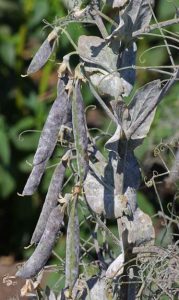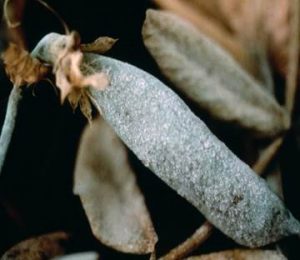Powdery mildew, caused by the pathogen Erysiphe pisi, can be a serious disease of peas in South Australia and Victoria. Severe infections can significantly reduce yield in susceptible varieties. Powdery mildew is most prevalent late in the season when warm days and cool nights result in dew formation.
Note: Downy mildew is caused by Peronospora viciae and is not the same fungus that causes powdery mildew.
What to Look For
Infected plants are covered with a white powdery film. Severely infected foliage turns blue-white in colour; tissue below these infected areas may turn purple. Symptoms first appear on the upper surfaces of the oldest leaves. Leaves, stems and pods may all become infected resulting in withering of the whole plant. Severe pod infection can cause a grey-brown discolouration of the seeds. These seeds have an objectionable flavour that lowers the quality of the grain.
Disease Cycle
The fungus over-winters on infected pea trash and produces spores which are blown by wind into new crops. Under favourable conditions the disease may completely colonise a plant in 5-6 days and once a few plants become infected it rapidly spreads to adjacent areas.
Warm (15-25°C), humid (over 70 per cent) conditions for 4-5 days late in the growing season during flowering and pod filling are favourable for disease development. Rainfall is not favourable for the disease, as it will wash spores off plants. Dewy nights are sufficient for disease development.
Management
Varietal Selection
Growing a resistant variety is the most effective means of controlling powdery mildew. Resistant varieties are immune to this disease and do not develop disease throughout the growing season.
Crop Rotation
Leave a four-year break between growing field pea crops in the same paddock. Control volunteer field peas which can harbour disease. Avoid sowing field pea crops adjacent to last season’s stubble. Incorporate or burn infected pea stubble soon after harvest where practicable.
Foliar Fungicides
Powdery mildew can be effectively controlled by fungicides sprays. Monitor crops from flowering onwards for signs of powdery mildew. If the disease is present the application of a foliar fungicide may be warranted. Fungicides need to be applied very early in disease development to be most effective. Fungicides for powdery mildew have limited systemic activity and will not protect the new growth following spraying. Good plant coverage with the fungicides is essential. Depending on disease pressure, foliage is protected for about 14 days.
Note: Fungicides used to control downy mildew have no activity against powdery mildew.





